Splitting Axe vs Maul – Which Do You Need?

These tools look similar and are mostly used the same way – but splitting axes and mauls are different and should be considered for different tasks.
Splitting axes have a 4-6 lbs head, with a sharp edge to penetrate and a wide profile to split wood apart. Mauls have a heavier 6-8lb head that can force its way through tough wood, and the back of the head is hardened to be used for hammering splitting wedges.
| Splitting Axe | Maul | |
|---|---|---|
| Use | Most wood | Large Logs |
| Head Weight | 4-6lbs | 6-8lbs |
| Length | 28-36″ | 36″ |
| Handle | Straight | Straight |
| Use with Wedges | No | Yes |
A splitting axe is better than a maul for a standard wood-splitting tool as the lighter head is easier to swing for longer periods, and more accurately once the rounds start to be broken apart.
A maul is for the largest, toughest rounds or to split large logs lengthwise. The extra weight helps penetrate and force the wood apart, plus the hardened pole (back of the head) on a maul can be used to drive splitting wedges where most splitting axes cannot.
Key Differences
Like with most tools, there are variations and exceptions to these standards but it’s a good starting point.
Mauls are Part Sledgehammer
There are many different patterns and designs of splitting axe and mauls, but the key consistent differences are the weight and the pole (back of the head).
The pole of a Maul is hardened and either rounded or tapered to be used as a sledgehammer for driving splitting wedges. The round or tapered shape prevents chipping and damage from striking, and thicker walls around the eye help the head withstand the impact. Splitting wedges are made from softer metals like magnesium to avoid damaging the maul.
Do not hammer the back of a maul with another maul or sledgehammer. The hardened metal colliding can chip or shatter (which is dangerous).
The pole of a splitting axe is typically not hardened, so you will likely damage the axe if you try and use it for hammering splitting wedges. Even though it looks capable, and has weight. The pole will mushroom, crack, and chips can fly off. And with enough use or effort, you can even warp the eye.
Now, to be honest – people still do it all the time. And a little hammering is not going to ruin the axe instantly. But it is best to be avoided, and that’s why I usually have an axe and maul on hand if I think I will need them.
Straight Handles
Both splitting axes and mauls come with straight handles, as they are stronger and more consistent when splitting wood.
Splitting axes will have an eye that fits a standard axe handle (straight or curved). While mauls may have either an axe eye or a round eye, which fits a sledgehammer handle.
I like the axe-handled mauls compared to the rounder grip of a sledgehammer handle, but it doesn’t really matter.
Splitting Axes should be Sharp
Splitting axes should have a sharp edge, to penetrate the wood and cut through fibers and knots. The first couple of inches of many splitting axe blades are often still somewhat thin, so the axe needs to dig in before it really spreads the wood apart.
Mauls need an edge but don’t have to be as Sharp
Some people will sharpen a maul like an axe, but you can get away with less.
A mauls blade should come to a clean edge to dig into the wood, however, it does not need to be truly sharp. Mauls rely primarily on force and inertia to drive through the wood.
When to use a Splitting Axe
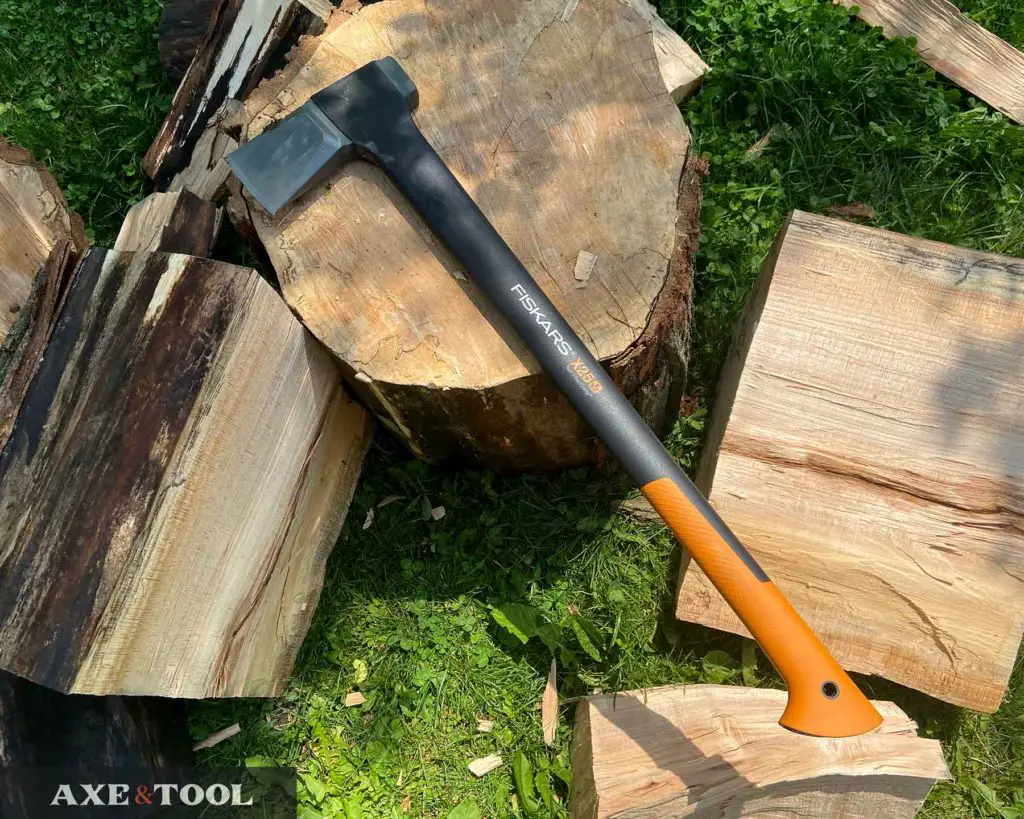
A splitting axe should be your primary splitting tool as it can be swung for much longer and more accurately than a maul. Even if you have large rounds, each progressive split gets easier meaning the maul wastes more energy with each swing.
With most of the swings coming after the largest rounds have been split, the lighter splitting axes are much easier to handle. I would rather swing the splitting axe 2 or 3 more times to get the first split than swing the maul for every swing after.
And don’t forget, even if you have really tough rounds – you don’t have to split through the middle. This is a common mistake, as I think we all naturally want to aim dead center. But it can be way easier to split slabs off around the outside, shrinking the round until it can be split through the middle.
When to use a Maul

For me, I keep a maul on hand as a support tool for tough splits and when the splitting axe is struggling. Some wood is just a pain, and the maul makes sense. When this happens I often try to go around and do the first splits on a bunch of rounds all at once – then switch back to my splitting axe.
Mauls can also be useful if the rounds have had a chance to season and harden – or if you are trying to split long logs lengthwise. For this, you may need the help of wedges, and (I’m going to repeat myself) you should always use a maul with wedges.
Wood vs Composite Splitting Axes & Mauls
I own and use both composite and wood-handled axes and mauls. And while the “purist” in me loves a classic wood handle – there is a really strong case for composite splitting axes and mauls. And I often recommend them.
Composite Axes & Mauls are Easier

Composite handles are durable, can withstand overstrikes, be used to help pry wood apart, and are unaffected by moisture or temperature. They require very little care (outside of occasional sharpening). You can use them, toss them in the shed, and be done with it.
Not all composite handles are created equal but the strong and flexible hollow handles from companies like Fiskars are incredibly light and absorb shock and vibration very well.
However, there is a limit to the quality of the steel on a composite-handled axe. Because composite handles can’t be replaced, the entire tool needs to be considered “disposable” and so the steels used tend to be a little softer and cheaper. This doesn’t mean they are bad, they just aren’t as hard as the more premium options.
Wood-Handled Axes & Mauls Require More Care
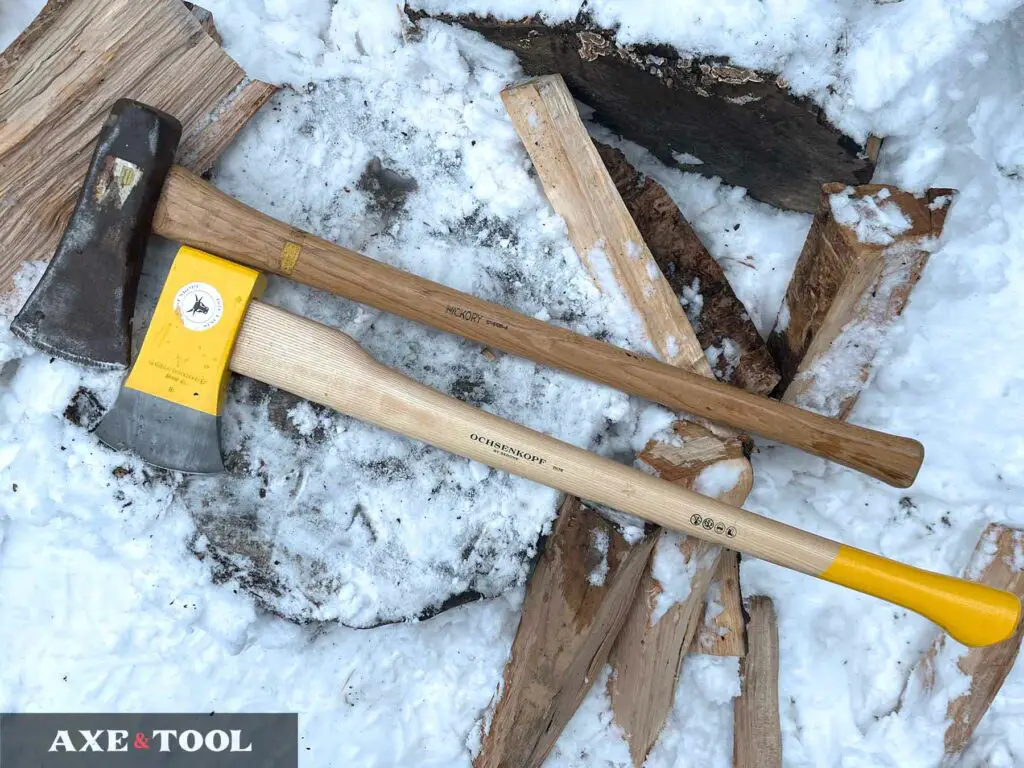
Wood handles have a great natural and tactile feel in the hand, and absorb shock. However, they can be damaged by overstrikes (which is common if you are new to using an axe) and be impacted by moisture and climate conditions without proper oiling and care.
Oiling a wood handle is essential for keeping an axe or maul handle strong and impervious to the weather. I also often use wax for these axes to add an extra barrier that will help stop rain or snow from seeping in.
All the high-end splitting axes and mauls will use a wood handle, as the high-carbon steel heads can last generations. So they will need to be able to be re-hung within their lifetime.
Top 3 Splitting Axes
There are 3 splitting axes that I recommend above the rest, and the nice thing is none of them are terribly expensive.
This is just a hobby, but if you buy through a link I may get a commission that supports the site. Thanks!
Fiskars X27 has Become the Standard
Fiskars are the splitting axes I have used the longest and the most. They are affordable and durable, you don’t need to care about them, and most importantly – they work.

I recommend the Fiskars X27 as an easy go-to composite splitter, and it is probably one of the most popular splitting axes around the world. It has a 4.5lb head which feels very light on the composite handle (the whole thing weighs just over 5 lbs), and it’s basically indestructible.
The edge starts narrow and digs in quickly, while the flared cheeks pop the wood apart. The composite handle is strong, light, and absorbs vibration really well. And the orange rubber grip does a surprisingly good job of damning vibrations in your hands too.
The initial narrow blade can be a little sticky in some softer woods, but it also cuts through stubborn twisted grain very well – so it’s a decent trade-off.
You can find them at almost all hardware stores, or on Amazon.
Fiskars actually offers a wide range of splitting axes (including my favorite, the shorter X25), and I have a full breakdown, if you want more details.
Ochsenkopf (Gedore) Spalt-Fix
This one is newer to me, but boy am I impressed.

The German-made heavy wedge of the Ochsenkopf Spalt-Fix seems to force its way through everything and never gets stuck. Ever. The head is a fat wedge that gets thick almost immediately, and the large German-style eye makes the head much wider than the Fiskars overall.
I also really like the fact that it’s 31″ inches long – which to me is a perfect size, and a little bit more nimble and accurate than the common 36″ options. They also offer the “Rotband” option that has a strong metal protective collar.
However, the 5.5lb head and the beefy handle do make this axe feel quite a bit heavier than the Fiskars (total weight is 6.8 lbs). It’s a serious axe, but it also starts to feel like overkill when you get down to the smaller pieces.
There are a couple of sizes (usually in metric), the big 5.5lb is 2500g – here is the Rotband version on Amazon.
Council Tool Splitting Axe
In 2022 Council Tool released a new splitting axe that has a lot of people excited. All their axes are made in the USA, and Council has built quite a reputation for offering incredibly high-value, innovative, and effective axes.

It has a 5lb head that is similar to a fat, heavy-weight Dayton pattern and it comes on either a 28″ or 36″ straight handle. Council Tool has made a name for itself by having probably the best-shaped standard handles on the market – especially for affordable axes (like this one).
This is the only tool on the list I haven’t got my hands on yet (it hasn’t made its way to Canada yet), but I own other Council Tool axes and have been very happy.
The Best Maul
There is really only one Maul I recommend consistently, and it’s the 8lb Fiskars IsoCore Maul. This thing is a beast.

The IsoCore maul absorbs more shock and impact than any other maul I have tried, and the head shape is designed to penetrate better with a thinner edge than many alternatives. It also has one of the largest h+
ammer surfaces out there, which makes it more forgiving when swinging at wedges.
Also very affordable, and available everywhere. Here it is on Amazon.
The Best Wood-handled Maul
If you want a wood-handled maul, you can usually find really cheap old mauls at garage sales or on Facebook marketplace that are way better than any of the crap coming from Mexico or China today.

But if I was going to buy one new – I would go for the Ochsenkopf “Big Ox”. It’s a 7lb maul, with a strong wedge shape, wide hammering surface, and a special pic at the bottom of the blade that can help you move wood around.
See the Big Ox on Amazon
If I missed something or you have any questions, feel free to leave me a comment below. I do my best to respond to everyone.
About the author:
About the author:
Jim Bell | Site Creator
I’m just a guy who likes axes. I got tired of only finding crap websites, so I set out to build a better one myself.
I’m also on Instagram: @axeandtool

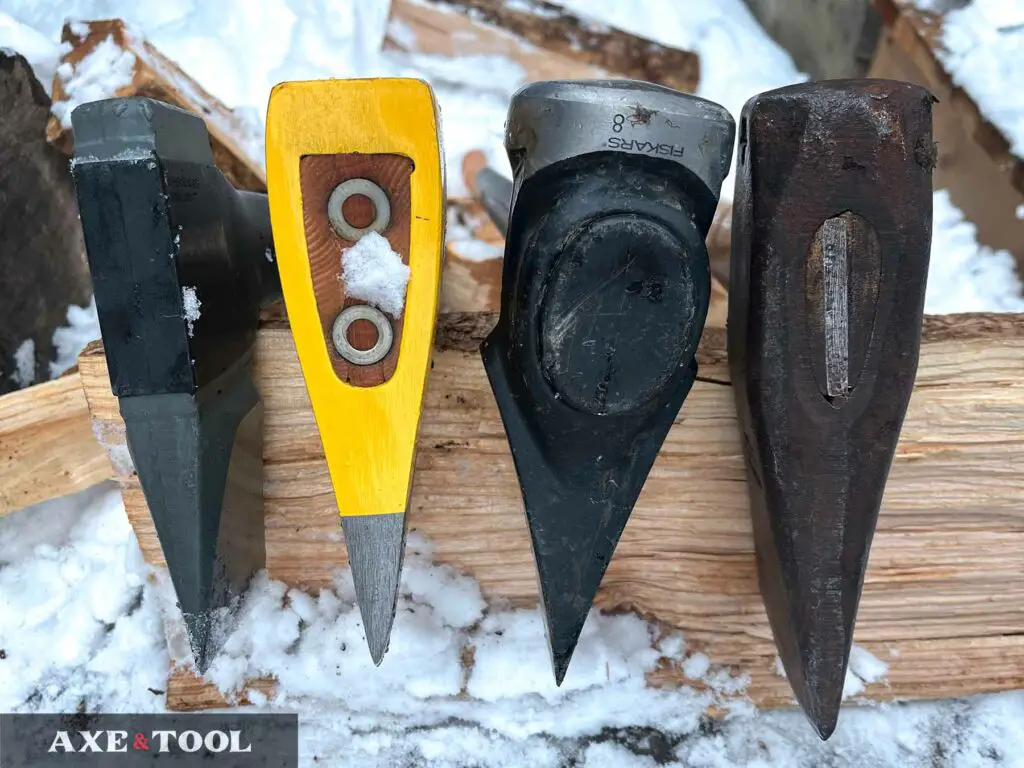
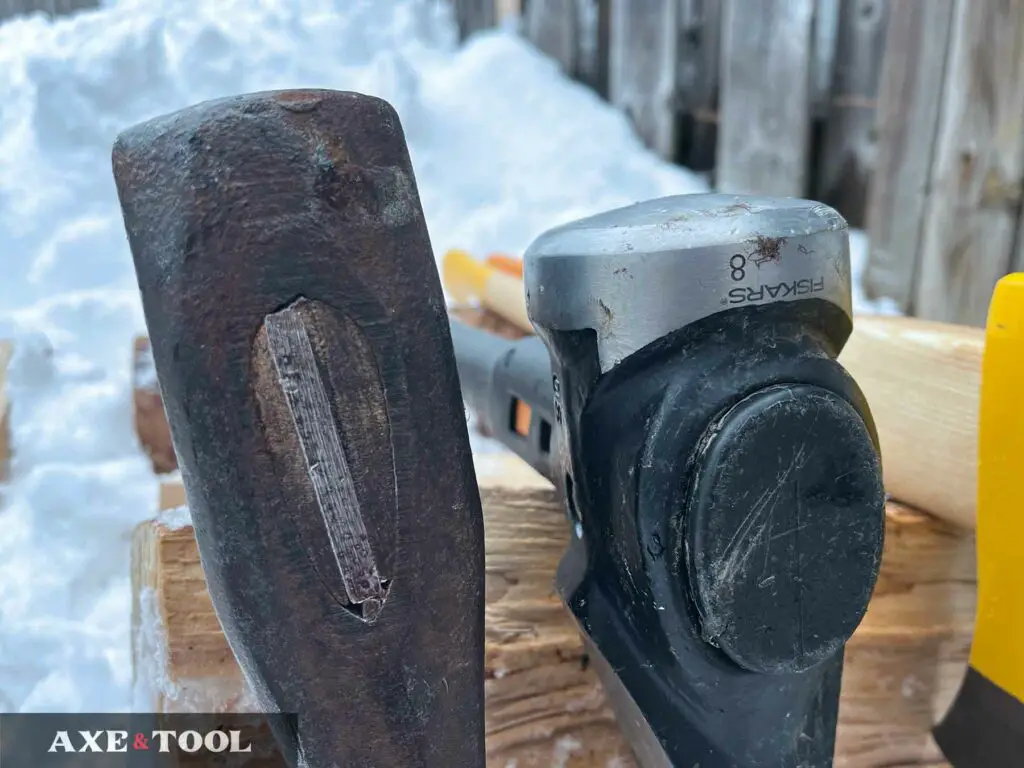
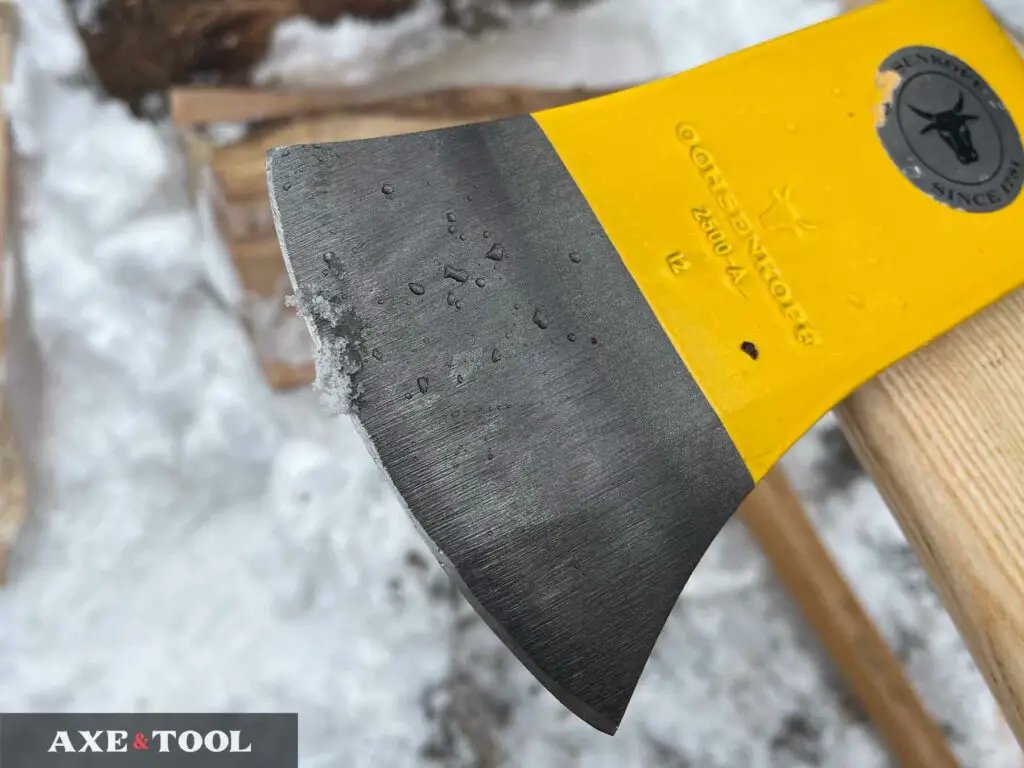



Thanks for the informative read. Really helped understand the differences and as an amateur the knowledge is priceless.
Glad it was useful! Thanks for the comment
Jim, I love your content. Have you considered covering the topic of the racing axe and Tasmanian patterns?
I just got myself a 6lb tuatahi work axe. This axe is a beast, totally worth the hype. I had never seen anything would cut like this: I downed a 5-inch tree in two swings! The land down under is nuts, and axe culture is certainly alive there.
Thanks! I would like to get there someday, I just don’t have any experience with Racing axes yet (Not that I haven’t admired the Tuatahis). I don’t want to write about anything I haven’t really got my hands on. Or in the future I might see if I can get someone who knows what they are doing to write about them – but for now it’s just me lol. Not there yet.
Hey Jim; long time no see. John B. here. I haven’t had any wood for a while, but a friend of a friend dropped off some chokecherry; so I’ll be busy for a while.
ANYWAY! Big news: FedEx just dropped off the 6lb Fiskars maul, and that 3lb? 28″ black handled splitting axe! OH BOY!
I’m making dinner right now, but after that’s done; you can bet I’ll be out in the back yard trying them out.
I apologize for not reading first; but did you ever pick up one of those 2 1/2lb splitting maul?
Apologize again if I am being redundant; but those new tools will compliment my X25 and 36″ Super Splitter axes, and my 2 1/2lb and 8lb maul, and the X7, X11, and X17!
Ha, sounds like you are getting a full collection. I had the X25 out the other day, it’s still my go-to most of the time. I also did get the little hand maul – it was basically what I expected, and I think the X11 outperforms it.
I agree completely. I just can’t find a niche for the mini-maul that one of the splitting axes couldn’t fill better.